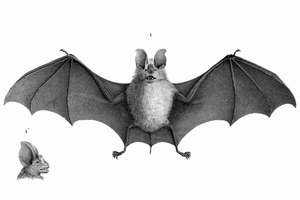Geoffroy's trident leaf nose
| Geoffroy's trident leaf nose | ||||||||||||
|---|---|---|---|---|---|---|---|---|---|---|---|---|

Drawing of Geoffroy's trident leaf nose |
||||||||||||
| Systematics | ||||||||||||
|
||||||||||||
| Scientific name | ||||||||||||
| Asellia tridens | ||||||||||||
| ( É. Geoffroy Saint-Hilaire , 1813) |
Geoffroy trident blade nose ( Asellia tridens ) is a species of bats of the genus trident sheet lugs ( Asellia ). This species can usually be easily distinguished from other species because of its three characteristic vertical appendages on the upper edge of the nasal blade.
Appearance
Geoffroy's trident- leaf-nosed bat is a medium-sized species of leaf-nosed bats with a complex-shaped nosepiece , which has three vertical appendages on its upper edge. The middle process is pointed, the two lateral ends blunt. The bat usually weighs between 8 and 12 g. The forearm of this species has a length of 46.0–54.1 mm. The ears are big. The short fur is brownish-sand-colored on the back and orange-brown on the underside. The fur of the young, however, is light gray and almost white on the underside. In Morocco there is a yellowish-brown fur coloration and the underside is lighter and cream-colored. The third finger reaches a length of 59-66 mm and the fifth a length of 46-52 mm. The tip of the tail protrudes 3–5 mm at rest and in flight considerably further over the edge of the tail membrane. The condylobasal length is 15.8 to 18.4 mm and the upper row of teeth is 6.3–7.7 mm long.
Males appear to be larger than females in this species.
distribution and habitat
The bat species occurs in Africa mainly in the Sahara and there also in its central areas. The animals are also common in north-west Africa south of the High Atlas . In Tunisia , Libya and Egypt the distribution extends to the Mediterranean Sea , south of the Sahara to Gambia and Somalia . In Asia it is found on the entire Arabian Peninsula , north to Israel and Syria and east to Pakistan .
Asellia tridens is a typical desert and semi-desert bat that inhabits large parts of the Sahara.
Quarters
It is a cave-dwelling species that can be found in underground passages, ruins, and wells. There are reports of animals in Morocco hanging low above the water in the underground water channels of oases (Rhettara) and caves.
behavior
The females of Geoffroy's trident-leaf nose can form colonies of several hundred to 5000 animals on the Arabian Peninsula. In addition to such breeding colonies, there are also male colonies of up to 50 individuals. Since the animals in Israel, Egypt and Morocco can only be found from May to October, migrations take place in unknown winter areas.
Reproduction
In this species, a single cub is born in late spring.
Foraging
Asellia tridens has longer wings and a higher wing area loading than the otherwise very similar small round-leaf nose . This can be seen as an adaptation to faster and less agile flight in open hunting habitats such as deserts and semi-deserts. However, hunting animals can also be encountered within oases. It can therefore be assumed that almost exclusively flying prey is hunted.
Location sounds
Geoffroy's trident leaf nose has long, frequency-heavy locating sounds between 117 and 124 kHz with a clearly pronounced frequency-modulated end part. Due to the frequency , it is also not comparable with any other species in North Africa.
food
The diet of this species consists mainly of beetles (35-80%), followed by butterflies , two-winged and right winged birds . Sometimes very large butterflies and grasshoppers are captured and eaten in resting places.
Danger
The International Union for Conservation of Nature and Natural Resources (IUCN) classifies Geoffroy's trident leaf nose as not endangered (least concern) , since the species has a large distribution area and the population is estimated to be stable.
Subspecies
It is not entirely known how many subspecies there actually are, as most of them do not clearly differ from one another. Most often, however, it is divided into the following subspecies:
- Asellia tridens tridens (E. Geoffroy, 1813)
- Asellia tridens murraiana Anderson, 1881
In other publications, the subspecies Asellia tridens diluta and Asellia tridens italosomalica are also listed.
literature
- Christian Dietz, Dietmar Nill, Otto von Helversen: Handbook of the bats - Europe and Northwest Africa. ISBN 978-3-440-14600-2 .
Individual evidence
- ↑ Asellia tridens in the endangered Red List species the IUCN 2017. Posted by: Monadjem, A. Bergman, W., Mickleburgh, S., Kock, D., AMR, ZSI & Hutson, AM, 2016. Accessed on 27th January 2019.
- ↑ https://www.itis.gov/servlet/SingleRpt/SingleRpt?search_topic=TSN&search_value=631474#null
- ↑ http://www.faunaparaguay.com/saug.pdf